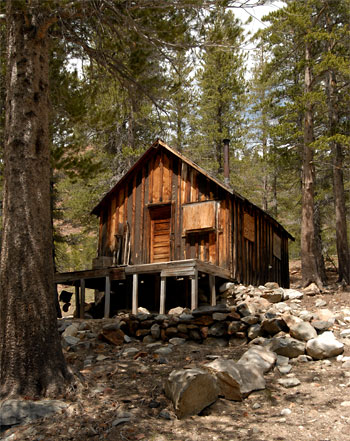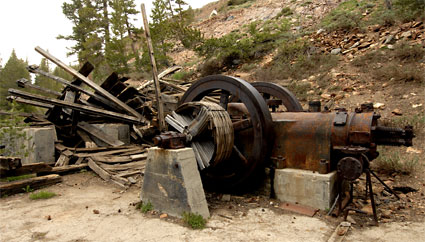|
Tucked away on the mountain high above Old Mammoth, and
modern day campgrounds, lies the site of the Mammoth Consolidated
Mine, circa 1927 -1933. Today we can still go back to that time
period, when the water wheels and horses of early day mining were
replaced by gas powered machinery and modern transportation.
The Mahan family was responsible for the Mammoth
Consolidated, and donated the buildings and equipment that you see
on the interpretive trail where remnants of buildings and machinery
still stand. In 1927, A.G. Mahan Sr., his son Arch, and several
partners purchased the claims under the full name of Mammoth
Consolidated Mining Company. Samples taken early on indicated six
tenths of an ounce of gold and one fifth of an ounce of silver per
ton of rock. At 1927 prices that would be approximately $12.70 per
ton. The mining company was located at the top of Red
Mountain, which got it's
name from the reddish orange iron sulphides in the rock. The iron
sulphides made extraction of the gold ore more expensive, but the
investors and owners were determined to keep the mine in operation
as long as they could. About $100,000 of gold was pulled out, but it
is doubtful that paid their expenses.
 |
| One
of four wood and tarpaper bunkhouses where miners lived at
the Mammoth Consolidated Mine. |
The bunkhouses are the first buildings we come to as we begin
the trail. Depending upon the time of year, there would have been
anywhere from six to fourteen workers in the high sierra camp.
Housing was provided in four tar paper-covered bunkhouses that were
heated by cast iron wood stoves, but had no electricity or running
water. The sun shining through the pocket windows and kerosene
lanterns provided the only light in the buildings. A miner made
$5.25 a day, which was good pay for the era. $1.25 of each days pay
went towards bed and board.
In addition to the miners, a cook, assayers, truck driver,
blacksmith and superintendent lived at the camp. Mrs. Pemberton was
a the cook. She was noted as a large woman that was not too
friendly. Little complaints were made about the meals Mrs. Pemberton
prepared on the old stove, probably because the men were afraid of
her temperament.
A.G. Mahon Sr. used a bedroom in the mining office, which
consisted of the office itself and the two bedrooms. One bedroom was
reserved for his use, the other was for visiting stockholders and
potential investors. Son and daughter in-law, Arch and Gladys Mahan
spent the warm months of the year in the lodgepole pine cabin that
was built sometime around 1929. During the harsh winter months Arch
would travel from
Los Angeles
every couple of
weeks. Skis and snowshoes were donned for the last 30 miles of
travel through snow depths which often reached as high as 25 feet
and temperatures known to dip below minus 30 to 40 degrees. Arch
carried the mail, payroll, and tobacco with him. Regular supplies
were brought in by dogsled during the winters, by local residents,
Bill Lewis and Tex Cushion.
Much of the ore processing mill still remains. The actual
frame that housed the 110 horsepower diesel engine and the equipment
it powered was destroyed in an avalanche sometime during the 1940's.
Large iron flywheels maintained smooth and continuous operation of
the big single-cylinder engine. A smaller wooden bullwheel drove a
20 inch wide leather belt. This was connected to the largest pulley
on the shaft. The rusty shaft remains, but the supporting 12 foot
floor is long gone. From the shaft, more belts and pulleys
distributed power to the machinery that was used to extract ore from
the rock.
 |
| The
110 HP Ingersol Rand diesel engine stands out amongst the
clutter in the remains of the ore processing mill. |
Carts transported ore from the mines. These carts were pushed
by the miners along a tramway to the processing mill. There it was
dumped onto the large coarse steel grate known as a “grizzly”.
The grizzly separated the rocks according to size, with the smaller
chunks falling on through the grates and the larger chunks being
rolled into the nearby jaw crusher to be turned into smaller chunks.
A bucket conveyor lifted ore to a storage bin where it was then fed
by small amounts into a barrel shaped container known as a “ball
mill”. The ball mill here was five feet across and contained fist
sized steel balls that pulverized the rock into sand as they bumbled
over and over again. The concrete pillar supports for the ball mill
still stand on the original old mill floor.
Read
More
|
